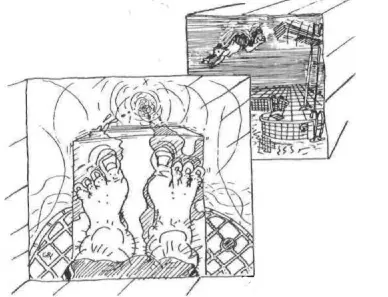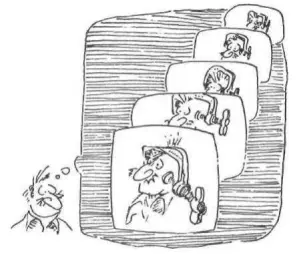Richard Bandler - Using Your Brain —for a CHANGE
- Название:Using Your Brain —for a CHANGE
- Автор:
- Жанр:
- Издательство:Real People Press
- Год:1985
- Город:Moab, Utah
- ISBN:0–911226–26–5
- Рейтинг:
- Избранное:Добавить в избранное
-
Отзывы:
-
Ваша оценка:
Richard Bandler - Using Your Brain —for a CHANGE краткое содержание
Bandler is an innovator and an original thinker in the field of psychology. This book is a transcript of Bandler live in front of an audience, cutting up and cracking jokes as he is prone to do, talking about some of his unique and often practical views on how you can change your feelings, thoughts and behavior. Change is often easier than you think if you use the right method.
Using Your Brain —for a CHANGE - читать онлайн бесплатно полную версию (весь текст целиком)
Интервал:
Закладка:
What I've just taught you is what I often do in a one–day or two–day seminar. The "standard" swish pattern is something that somebody can grab hold of and use, and it will work more often than not. But it doesn't demonstrate to me any competent understanding of what the underlying pattern is. If you give anyone a cookbook, he can bake a cake. But if you give a chef a cookbook, he'll come up with a better product. A really fine chef knows things about the chemistry of cooking that guide what he does and how he does it. He knows what the egg whites are doing in there; he know what their function is. To a chef, it isn't just a matter of throwing a bunch of stuff together and whipping it up. He knows that certain things make things gel into a certain consistency, certain things have to be added in a particular order, and certain other ingredients have to do with changing the flavor in one way or another.
The same thing is true when you begin to use the swish pattern. As a first step toward becoming a chef, I want you to try using the swish pattern again, but find out what happens if you change one element. Last time we used the submodalities of size, brightness and association/dissociation as the elements that change as one picture swishes to the other.
Two of those elements, size and brightness, are elements that change continuously over a range. Anything that can be changed gradually is called an analogue variable. Association/dissociation is what we call a digital variable, because it's either one or the other. You are either inside of an experience, or outside of it; you don't gradually go from one to the other. Association/dissociation will always be one element of the swish. The other two analogue elements can be any two elements that have a powerful effect for the person.
This time I want you to keep everything the same, except you'll use distance instead of size. The first picture will start out bright and close. The second picture will start out dark and far away, and then it will quickly come closer as it brightens, while the first picture recedes into the distance and darkens. This is a fairly small change, and to some of you it may not seem different at all, since size and closeness are strongly correlated. But it is a first step toward teaching you how to use the swish pattern in a much more general and flexible way. Take another fifteen minutes to do the swish with distance, instead of size.

Did using distance rather than size make a difference for some of you? You can use any submodality distinctions to do the swish, but it will only work well if the distinctions you use are subjectively powerful to the person you are working with. Brightness and size are powerful for most people, so the version I taught you first will work more often than not. Distance is another submodality that is important to many people, so I had you try that one next. But if size, brightness, and distance aren't important to the person, then you have to find out which submodalities are impactful, and design a swish using those.
A couple of years ago I saw three clients for a videotape session (see Appendix II). The first client I saw was a woman who was suffering from "anticipatory loss." I love the names they come up with to describe how people are messed up! What it boiled down to was that if she had arranged to meet someone who was close to her and that person was a half–hour late, she had what she called a panic attack. She lost her marbles and began to step on them. When I asked her what she would like to have from the session, this is what she said:
I have a problem with a fear that is almost disabling to me at certain times. When I have it, I sort of go into panic attacks. What I would like to do is distance myself, so that when I'm in the situation I wouldn't experience the fear to the degree that I have it, where I could control myself and make better decisions.
Since she talked about wanting to "distance" herself, she gave me a clear indication that distance was an important submodality for her. She also talked a lot about people who were "close to her" and "close relationships." Later when talking about what she did when someone was late she said, "I need to allow them some distance — I mean allow them some time." With this woman a swish using distance will be much more powerful than one using size. In fact, I went ahead and tried the standard swish using size to find out if it would work. It had very little impact. Then I used distance, and it worked perfectly.
The most important part of doing the swish in a really artistic way is to carefully gather the information you need to set it up appropriately. When someone talks about something being "bigger than life" or being "blown out of proportion," that's a pretty good indication that size is an important variable to use.
When somebody describes a limitation he wants to change, you need to be able to pay attention to how this particular problem works. I always keep in mind that anything that anybody has done is an achievement, no matter how futile or painful it may be. People aren't broken; they work perfectly! The important question is, "How do they work now?" so that you can help them work perfectly in a way that is more pleasant and useful.
One of the things I do to gather information is to say to the client, "Well, let's say I had to fill in for you for a day. One of the things I would have to do is have your limitation. How would I do it? You have to teach me how to have this problem." As I begin to presuppose that it's an achievement — something learned that can be taught to someone else — it entirely changes the way the person is able to deal with and think about the difficulty.
When I asked the woman who panicked when people were late to teach me how to do it, she said:
You start telling yourself sentences like, "They're late; they may never come."
Do you say this in a bored tone of voice — "Ho hum"?
No. The voice starts out slowly, "Give them another half hour." Then it speeds up as the time gets closer.
Do you have any pictures in there?
Yes. I see a picture of the person maybe in a wreck, as if I'm standing there looking on, like through a zoom lens. At other times I'm looking around through my own eyes out at the world and there's no one there.
So in her case she has a voice that speeds up and rises in pitch as time goes on. At a certain point the voice says, "They'll never come" and she makes close–up, zoom–lens pictures of the person in a wreck, or of being all alone.
When I asked her to try making the picture of the wreck, I found that zooming in or out had a very strong effect. When I tested brightness, she said, "The dimness creates distance." That tells me that brightness is also a factor.
Now I want you to pair up with someone and ask him to think of a limitation — something that he considers a problem and wants to change. This time I don't want you to fix it; I only want you to find out how this achievement works. Use the frame of "Let's say I had to fill in for you for a day. Teach me what to do." Do the same thing you did earlier when you found out how a person got motivated to do something.
Whenever someone is compulsed to do something he doesn't want to do, something inside has to amplify to a certain point. Something has to get bigger or brighter or louder, or the tone changes, or the tempo speeds up or slows down. I want you to find out how this person achieves this particular limitation. First ask him when to do it, and then find out how he does it: what does he do on the inside that drives his response? When you think you have identified the crucial submodalities, test by asking your partner to vary them one at a time, and observe how it changes his response. Then ask him to take a different picture and again vary the same submodalities, to see if it changes his response to this other picture in the same way. Find out enough about how it works so that you could do this person's limitation if you wanted to. When you have this information, it will tell you precisely how to swish this particular individual. Don't actually swish them; just gather the information. Take about a half hour.

Man: My partner has two pictures representing two different states: desirable and undesirable. In one of them he sees jerky movement, and in the other one the movements are smooth and graceful,
OK. Do these two pictures create and maintain whatever he considered to be the difficulty? That was my question. I didn't ask about where the person wants to go yet: I only asked how he creates the difficulty. With the woman with panic attacks, she has to get from the state of "Ho, hum" to the state of "freaking out." She starts with a voice and pictures. Then she has to make the voice get faster and higher–pitched, and the picture gets closer and closer as time runs out.
Man: My partner has a feeling of urgency—
Of course. That's the feeling of compulsion. But how does he make that feeling? What is the critical submodality? In essence, what you want to know is, "How does this person already swish himself from one state of consciousness to another?"
Man: What makes it different for him is wrapping the picture around him. He pulls it in and around himself and steps into the picture and looks at the picture from his own eyes.
OK. Good. That's how he gets into the state he doesn't want to be in.
Man: Yes. He first gets into that state, and then dissociates by stepping out of it, putting it back over here to his left, away from him, and stands at a distance of several feet away from it,
OK. So association/dissociation is the critical submodality There aren't that many choices, so we are going to find some repetition. What other critical submodalities did the rest of you find?
Woman: The width of the picture, along with brightness, were critical. When the picture narrowed and dimmed, she felt constrained.
That makes sense. If you get skinny pictures, you feel constrained.
Woman: What she did was like a synesthesia.
These all work by synesthesia. That's what we're experimenting with. Think about it. When you change the brightness of an image, it changes the intensity of your feelings. These are all synesthesias. What we want to know is how they are related, so we can use that relationship to build a swish.
What you need to know in order to build a swish for her is whether or not narrowing any picture makes her response stronger, and whether dimming any picture makes her response stronger. You see, it may be that she uses the word "constrained" because she doesn't like the particular choice that she's left with in that picture. If she sees a choice she likes and the picture narrows, she may describe the feeling as "purposeful," or "committed." If narrowing and dimming make her response stronger, you can build a swish for her by starting with a narrow, dim "problem state" picture which gets wider and brighter as the desired state picture gets narrower and dimmer. That will sound strange to most of you, but keep in mind that everyone's brain is coded somewhat differently. What makes the swish really elegant is designing it so that a particular brain will respond to it strongly.
The other alternative is that making this particular picture of few choices narrow increases the intensity her feeling constrained, but that making an image of her with choices gets a stronger response if she broadens it. In that case, you could have the problem picture narrow down to a line, and the solution picture open up out of that same line. So you'll have to go back and find out more about how it works before you'll know the best way to design a swish for her.
Читать дальшеИнтервал:
Закладка:








